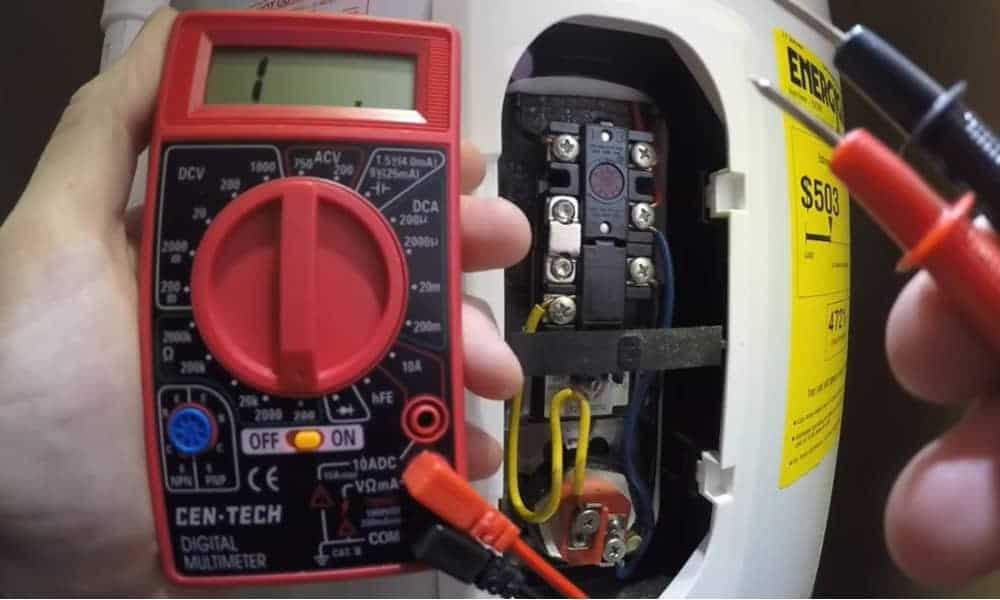To test a water heater element with a multimeter, first make sure that the power is off to the water heater. Then remove the access panel to the element and disconnect the wires. Next, use the multimeter to test for continuity between the terminals of the element.
If there is no continuity, then the element needs to be replaced.
If your water heater isn’t working as well as it used to, one possible issue could be a faulty element. You can test your water heater element with a multimeter to see if it is the problem.
First, make sure that the power to your water heater is turned off.
Then, remove the access panel to the elements and unscrew the element from its socket.
Next, connect one lead of the multimeter to the element’s terminal screw and touch the other lead to the metal part of the element. If you get a reading on the multimeter, then the element is good.
If not, then it will need to be replaced.

Credit: www.sunrisespecialty.com
How Many Ohms Should a Water Heater Element Read?
If your water heater element is reading too high in resistance, it could be an indication that the element is burned out. The most common range for ohms on a water heater element is between 20 and 30 ohms. If your element is reading above this range, it’s time to replace it.
How Can You Tell If a Water Heater Element is Bad?
If your water heater is not heating up the water or if it’s taking too long to heat up, then there’s a chance that the element could be bad. There are a few ways that you can test this.
The first way is to simply test the element with a multimeter.
You’ll want to disconnect the power to the water heater before you do this though. Once it’s disconnected, touch one lead of the multimeter to each of the terminals on the element. If the multimeter reads zero, or close to zero, then there’s a good chance that the element is bad and needs to be replaced.
Another way to tell if an element is bad is by feeling it with your hand. Be careful when doing this as elements can get very hot! If it feels significantly cooler than other elements in your water heater, then chances are it’s not working properly and should be replaced.
If you have any doubts about whether or not an element is bad, it’s always best to consult with a professional who can test it for you and give you their expert opinion.
What Continuity Should a Water Heater Element Be?
There are a few different things to consider when it comes to the continuity of a water heater element. First, you’ll want to make sure that the element is properly sized for the tank. Next, you’ll need to check the voltage and amperage rating of the element to be sure it is compatible with your system.
Finally, you’ll want to test the element for continuity before installation.
If you’re unsure about any of these steps, it’s always best to consult with a professional. Improperly installed or incompatible elements can cause serious damage to your water heater and pose a serious safety risk.
How Do I Test an Electric Water Heater With a Multimeter?
If you have an electric water heater, you can test it with a multimeter. First, make sure that the power is off to the water heater. Then, remove the access panel to the heating element.
You should see two screws or bolts holding the element in place. Use your multimeter to test for continuity between the two terminals on the heating element. If there is continuity, then the element is good.
If there is no continuity, then the element needs to be replaced.
How To Test Water Heater Element With Multimeter
How to Test a Kettle Element With a Multimeter
If your kettle is taking longer than usual to boil, it may be time to check the element. This can easily be done at home with a multimeter. All you need to do is remove the kettle’s base and unscrew the element.
Once it’s exposed, you can test it using the following steps:
1. Set your multimeter to Ohms and touch the probes to the terminal points of the element.
2. If there is continuity, then the element is fine.
However, if there is no continuity or a very high resistance reading, then this indicates that the element needs to be replaced.
3. To double-check, you can also test for voltage by setting your multimeter to AC Volts and touching one probe to each of the terminal points while the kettle is plugged in and turned on. If there is voltage present, then this means that power is reaching the element but it’s not heating up properly which could also indicate that it needs to be replaced.
How to Test Water Heater Element Without Multimeter
If your water heater isn’t working as efficiently as it used to, there are a few things you can check before calling in a professional. One of those is the element. Over time, the element can become corroded or otherwise damaged, which can cause it to stop working properly.
Fortunately, testing the element is relatively easy and only requires a multimeter. First, locate the two terminals on the element. You’ll need to remove any power from the unit before continuing, so either shut off the breaker or unplug it from the wall outlet.
Once you’ve done that, touch one lead of the multimeter to each terminal and turn on the power.
If the element is working properly, you should see a reading of around 240 volts on the multimeter display. If not, then it’s likely that the element needs to be replaced.
How to Check Heating Element With Multimeter
If your dryer isn’t heating up, it could be due to a faulty heating element. To test whether the element is working, you’ll need to use a multimeter. Here’s how:
First, make sure that the power to your dryer is turned off. Then, remove the back panel of the dryer so you can access the heating element.
Next, using your multimeter, set it to the Ohms setting and touch one lead to each terminal on the heating element.
If the reading is zero or close to zero, then the element is working properly.
If you get a reading of infinity or OL (overload), then the heating element is most likely defective and will need to be replaced.
How to Test a Heating Element
A heating element is a crucial part of many appliances, and if it isn’t working properly, the appliance won’t function correctly. Testing a heating element is a simple process that anyone can do with a few tools.
To test a heating element, you’ll need an ohmmeter/multimeter.
You’ll also need to remove the heating element from the appliance so that you can access it directly. Once you have your tools and access to the heating element, follow these steps:
1. With the ohmmeter set to the appropriate range, touch one probe to each terminal on the heating element.
If the reading is infinite (open circuit), then the element is defective and needs to be replaced. If the reading is zero or close to zero, then there may be another problem with the appliance and further testing will be necessary.
2. If you get a reading that indicates continuity (a low resistance value), then test for resistance again while slowly moving one of the probes along the length oftheelement .
The resistance should be uniform throughout; if there are any sudden changes in resistance, thentheelementis probably defective and needs to be replaced.
If everything looks good so far, congratulations! Your heating element is probably fine.
However, there’s one more test you can perform to make sure everything is working as it should be:
3. With both probes still touchingthe terminalsofheatingelement , heat uptheelementwitha lighter or other flame .
Conclusion
If your water heater isn’t giving you hot water, or if it’s not working as well as it used to, one of the first things you should check is the elements. You can test a water heater element with a multimeter to see if it’s burned out.
First, make sure that the power is off to the water heater.
Then, remove the access panel and locate the elements. You’ll need to test each element individually.
To test an element, touch one lead of the multimeter to each of the screw terminals on the element.
If the multimeter reads continuity, then the element is good. If there is no continuity, then the element needs to be replaced.
